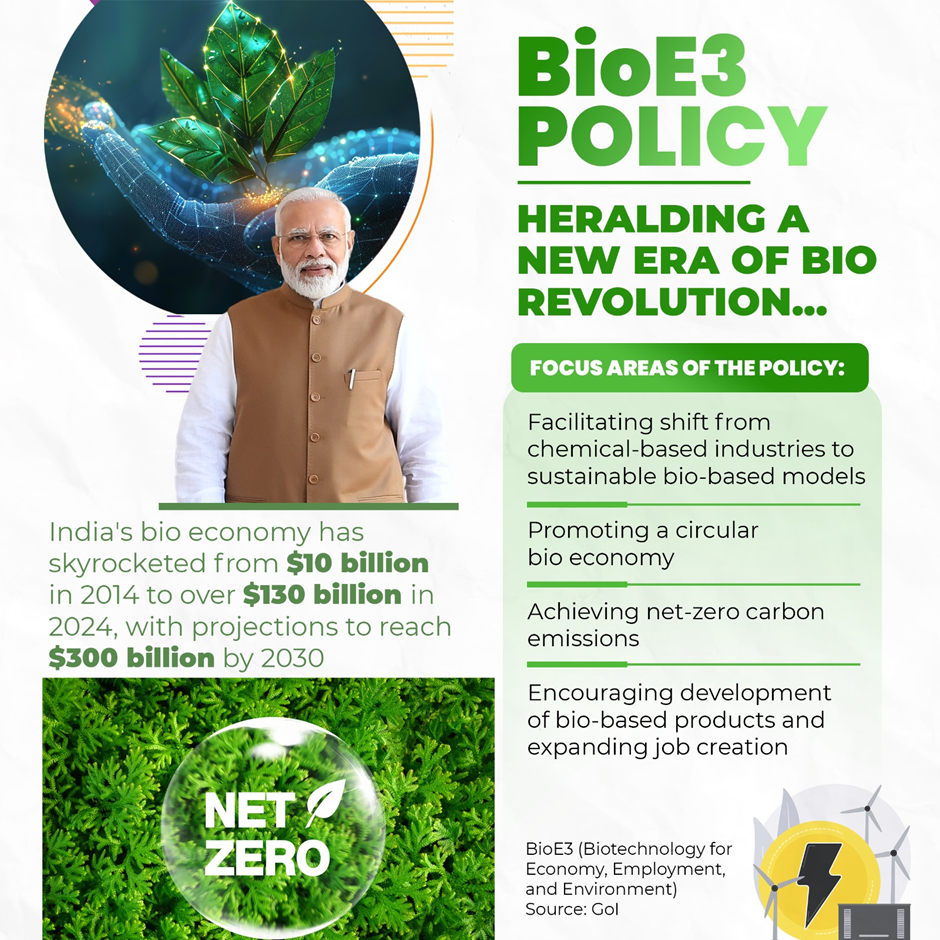- Courses
- GS Full Course 1 Year
- GS Full Course 2 Year
- GS Full Course 3 Year
- GS Full Course Till Selection
- Answer Alpha: Mains 2025 Mentorship
- MEP (Mains Enrichment Programme) Data, Facts
- Essay Target – 150+ Marks
- Online Program
- GS Recorded Course
- Polity
- Geography
- Economy
- Ancient, Medieval and Art & Culture AMAC
- Modern India, Post Independence & World History
- Environment
- Governance
- Science & Technology
- International Relations and Internal Security
- Disaster Management
- Ethics
- NCERT Current Affairs
- Indian Society and Social Issue
- NCERT- Science and Technology
- NCERT - Geography
- NCERT - Ancient History
- NCERT- World History
- NCERT Modern History
- CSAT
- 5 LAYERED ARJUNA Mentorship
- Public Administration Optional
- ABOUT US
- OUR TOPPERS
- TEST SERIES
- FREE STUDY MATERIAL
- VIDEOS
- CONTACT US
BioE3: India’s Biotech Revolution
BioE3: India’s Biotech Revolution
02-09-2024

India's Cabinet has approved the BioE3 (Biotechnology for Economy, Environment, and Employment) proposal to elevate its biotechnology sector.
- This initiative aims to expand bio-based chemicals, functional foods, precision biotherapeutics, climate-resilient agriculture, carbon capture, and marine/space research.
- However, the success of BioE3 depends on sustained financial and infrastructural backing from both central and state governments.
- While India is already making notable strides in biotechnology, further development is crucial for realizing its full potential and contributing globally.
Current Status of India’s Biotechnology Sector
- Global Standing: India ranks among the top 12 global biotechnology destinations and is the 3rd largest in the Asia-Pacific region. The country’s Bioeconomy reached USD 130 billion in 2024.
-
Biotechnology Categories:
- Biopharmaceuticals: Leading in low-cost drugs and vaccines, and a pioneer in biosimilars.
- Bio-Agriculture: The sector has significant potential, with 55% of land used for agriculture and room for growth from USD 10.5 billion to USD 20 billion by 2025.
- Bio-Industrial: Biotechnology is revolutionizing industrial processes and waste disposal.
- Bio IT & BioServices: Strong in contract manufacturing, research, and clinical trials, with numerous US FDA-approved plants.
-
Government Initiatives:
- 100% FDI allowed in greenfield pharma and medical devices.
- National Biotechnology Development Strategy 2021-25 targets a USD 150 billion Bioeconomy by 2025.
- Biotech-KISAN hubs connect farmers with scientists for sustainable agriculture.
- Union Budget 2023-24 includes 500 ‘waste to wealth’ plants under GOBARdhan.
- GenomeIndia Project focuses on genetic diversity for public health.
Significance of Biotechnology for India
- Economic Growth: The biotech industry is projected to reach USD 150 billion by 2025, contributing to India's GDP and job creation.
- Vaccine Production: India, known as the "pharmacy of the world," produces 60% of global vaccines, enhancing global health security.
- Agricultural Innovation: Biotech solutions like Bt cotton and drought-resistant rice can revolutionize food security and farmer incomes.
- Environmental Protection: Biotechnology addresses pollution, waste management, and climate change challenges with innovations like bioremediation and carbon capture.
- Innovation Ecosystem: Over 5,000 biotech startups are driving research and commercialization, with government initiatives fostering further growth.
- Self-Reliance: Biotechnology helps reduce import dependence in critical sectors like pharmaceuticals, plastics, and biofuels.
- Future Frontiers: Marine and space biotechnology could lead to new discoveries and innovations applicable on Earth.
Key Challenges Hindering Growth
- Regulatory Issues: A complex regulatory environment and slow approval processes for GMOs hinder innovation.
- Funding Gaps: Limited access to funding, high risks, and long development periods challenge biotech firms.
- Infrastructure Shortcomings: Insufficient high-end research facilities and cold chain infrastructure.
- IP Protection: Intellectual property concerns and enforcement challenges.
- Global Competition: Indian firms face intense competition from established global players.
- Talent Shortages: Brain drain and skill gaps in cutting-edge areas like bioinformatics.
- Ethical Concerns: Complex ethical issues in biotech research, such as GMOs and gene editing.
Measures to Enhance the Biotechnology Sector
- Regulatory Reforms: Create a unified Biotechnology Regulatory Authority of India (BRAI) and streamline approval processes.
- Funding Strategies: Establish a Biotechnology Investment Fund with public-private partnerships.
- Talent Development: Launch skill development programs and integrate biotech education with industry needs.
- Infrastructure Investment: Develop shared research facilities and biotech manufacturing zones.
- IP Strengthening: Improve IP protection and establish a Biotech Patent Pool for collaborative research.
- Manufacturing Boost: Expand the Production Linked Incentive (PLI) scheme for a wider range of biotech products.
Conclusion
The BioE3 initiative represents a significant advancement in harnessing India’s biotechnology potential. To succeed, it requires robust support and effective collaboration between central and state governments. If implemented successfully, it could drive economic growth, enhance environmental sustainability, and create employment opportunities, positioning India as a global leader in biotechnology and sustainable development.
Must Check: Best IAS Coaching In Delhi
UPSC Prelims Result 2024 Out: Expected Cut Off & Other Details, UPSC Prelims 2024 Answer with Explanation, Daily Prelims Quiz, Daily Current Affairs, MONTHLY CURRENT AFFAIRS TOTAL (CAT) MAGAZINE, Best IAS Coaching Institute in Karol Bagh, Best IAS Coaching Institute in Delhi, Daily Mains Question Answer Practice, ENSURE IAS UPSC Toppers, UPSC Toppers Marksheet, Previous Year Interview Questions, UPSC Syllabus




